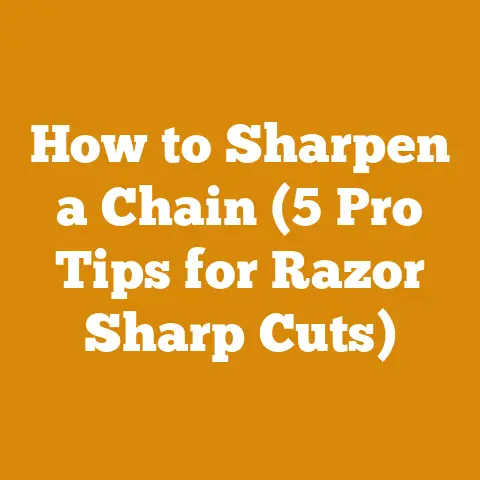Dremel Chainsaw Sharpening Bits Explained (5 Pro Tips)
Unlock Razor-Sharp Chainsaw Performance: A Deep Dive into Dremel Sharpening Bits and Pro Techniques
Have you ever felt the frustration of a chainsaw chain that just wouldn’t bite, turning a productive afternoon into a wrestling match with wood?
A dull chain isn’t just annoying; it’s dangerous and inefficient.
But fear not!
This guide will empower you to restore your chainsaw’s cutting prowess using the humble Dremel rotary tool and its specialized sharpening bits.
I will walk you through the process, share my personal experiences, and arm you with pro tips that will have you sharpening like a seasoned logger in no time.
The State of the Chainsaw: A Global Perspective
Before we dive into the nitty-gritty of sharpening, let’s take a moment to appreciate the ubiquitous chainsaw.
Globally, the wood processing and firewood industry is a multi-billion dollar market, heavily reliant on the efficiency and effectiveness of this powerful tool.
According to recent reports, the global chainsaw market is projected to reach \$4.5 billion by 2028, fueled by increasing demand for timber, firewood, and landscaping services.
Whether you’re a professional logger in the Pacific Northwest, a small firewood producer in rural Europe, or a homeowner tackling yard maintenance, the chainsaw is an indispensable companion.
But with great power comes great responsibility, and a crucial aspect of chainsaw maintenance is keeping that chain sharp.
A sharp chain not only increases cutting efficiency but also significantly reduces the risk of kickback, a leading cause of chainsaw injuries.
My Chainsaw Saga: From Dull Disappointment to Sharpening Success
I remember the first time I tried to fell a small tree with a brand-new chainsaw.
I was full of confidence, ready to tackle the task.
But as soon as the chain met the wood, disappointment set in.
The saw bucked and vibrated, producing sawdust instead of clean chips.
It was like trying to cut butter with a spoon.
I was quickly humbled.
That experience ignited my passion for chainsaw maintenance, and I embarked on a journey to learn the art of sharpening.
I tried various methods, from traditional files to electric sharpeners.
But it was the Dremel rotary tool that truly revolutionized my sharpening game.
Its precision and versatility allowed me to achieve a level of sharpness I never thought possible.
What is a Chainsaw Sharpening Bit? Demystifying the Options
A chainsaw sharpening bit is a small, abrasive grinding wheel designed to be used with a rotary tool like a Dremel.
These bits come in various shapes, sizes, and materials, each suited for different chain types and sharpening techniques.
Understanding the different types of bits is crucial for achieving optimal results.
- Aluminum Oxide Bits: These are the most common type of sharpening bits and are suitable for general-purpose sharpening of most chainsaw chains.
They are relatively inexpensive and readily available. - Silicon Carbide Bits: These bits are harder and more aggressive than aluminum oxide bits, making them ideal for sharpening chains that are heavily worn or damaged.
They also work well on harder metals. - Diamond-Coated Bits: These are the premium option, offering exceptional durability and precision.
They are particularly well-suited for sharpening carbide-tipped chains, which are becoming increasingly popular for their extended lifespan and superior cutting performance.
Choosing the Right Bit: A Step-by-Step Guide
Selecting the correct sharpening bit is paramount. Here’s my proven method:
- Identify Your Chain Type: Consult your chainsaw’s manual or examine the chain itself to determine its type (e.g., 3/8″ pitch, .050″ gauge).
This information is crucial for selecting the correct bit size. - Match Bit Size to Chain Specifications: The bit size should correspond to the chain’s pitch and gauge.
Using a bit that is too large or too small can damage the chain and compromise its cutting performance.
Most Dremel bit manufacturers provide charts that cross-reference chain specifications with recommended bit sizes. - Consider the Chain’s Condition: If your chain is only slightly dull, an aluminum oxide bit will suffice.
If it’s heavily worn or damaged, a silicon carbide bit may be necessary.
For carbide-tipped chains, always use a diamond-coated bit. - Prioritize Quality: Invest in high-quality sharpening bits from reputable manufacturers.
Cheap bits may wear out quickly or produce uneven sharpening, leading to unsatisfactory results. - Start with a Variety Pack: If you’re new to Dremel sharpening, consider purchasing a variety pack of bits.
This will allow you to experiment with different types and sizes to find what works best for your chain and sharpening technique.
Pro Tip #1: Mastering the Angle Guide for Consistent Sharpening
One of the biggest challenges in chainsaw sharpening is maintaining a consistent angle on each tooth.
The angle guide, often included with Dremel sharpening kits, is your secret weapon for achieving this consistency.
- Understanding the Angle Guide: The angle guide is a small attachment that fits onto your Dremel tool.
It features a series of markings that indicate the correct sharpening angle for different chain types. - Setting the Correct Angle: Consult your chainsaw’s manual or the chain manufacturer’s specifications to determine the recommended sharpening angle.
Adjust the angle guide accordingly. - Maintaining a Steady Hand: When sharpening, keep the angle guide firmly pressed against the chain’s cutter.
This will ensure that you maintain the correct angle throughout the sharpening process. - Practice Makes Perfect: It may take some practice to get the hang of using the angle guide.
Don’t be discouraged if your first few attempts aren’t perfect.
With persistence, you’ll develop the muscle memory and precision needed to achieve consistent results.
My Angle Guide Revelation:
I initially scoffed at the angle guide, thinking I could freehand the sharpening.
Big mistake!
My chain ended up with inconsistent angles, leading to uneven cutting and premature wear.
Once I embraced the angle guide, my sharpening results improved dramatically.
It’s like having a built-in sharpening expert guiding your every move.
Pro Tip #2: The Art of Depth Control: Preventing Over-Sharpening
Over-sharpening is a common mistake that can significantly reduce the lifespan of your chainsaw chain.
Removing too much material from the cutters weakens them and makes them more susceptible to damage.
The key to preventing over-sharpening is mastering depth control.
- Observe the Cutter’s Shape: Before you begin sharpening, carefully examine the shape of the cutters.
Note the amount of wear and the overall profile.
Your goal is to restore the cutter to its original shape, not to drastically alter it. - Use Light Pressure: Apply gentle pressure to the sharpening bit.
Avoid pressing too hard, as this can remove material too quickly and lead to over-sharpening. - Make Short, Controlled Passes: Instead of making long, sweeping passes, use short, controlled strokes.
This will give you more control over the amount of material being removed. - Check Your Progress Frequently: Stop frequently to check your progress.
Compare the sharpened cutter to an unsharpened cutter to ensure that you’re not removing too much material. - Invest in a Depth Gauge: A depth gauge is a small tool that measures the height of the depth gauges (also known as rakers) on your chain.
Maintaining the correct depth gauge height is crucial for optimal cutting performance.
If the depth gauges are too high, the chain will not bite properly.
If they are too low, the chain will be too aggressive and prone to kickback.
Data Point: The Impact of Over-Sharpening
Research conducted by Oregon Tool, a leading manufacturer of chainsaw chains, has shown that over-sharpening can reduce a chain’s lifespan by as much as 50%.
This highlights the importance of mastering depth control to maximize the value of your chainsaw chain.
Pro Tip #3: The “Touch-and-Go” Technique: Sharpening Like a Pro
The “touch-and-go” technique is a subtle but powerful sharpening method that I’ve honed over years of experience.
It involves using a very light touch and making quick, fleeting passes with the sharpening bit.
- Visualize the Cutter’s Edge: Before you begin, visualize the cutting edge of the cutter.
Imagine the shape you want to achieve. - Light as a Feather: Apply the lightest possible pressure to the sharpening bit.
You should barely feel the bit making contact with the cutter. - Quick, Fleeting Passes: Make quick, fleeting passes with the sharpening bit, almost as if you’re just kissing the cutter’s edge.
- Gradual Refinement: Gradually refine the cutter’s edge, making small adjustments with each pass.
- Listen to the Sound: Pay attention to the sound of the sharpening bit.
A smooth, consistent sound indicates that you’re sharpening correctly.
A harsh, grinding sound suggests that you’re applying too much pressure.
The Touch-and-Go Revelation:
I used to approach sharpening with a heavy hand, grinding away at the cutters with gusto.
But I quickly learned that this approach was counterproductive.
The “touch-and-go” technique allows you to achieve a razor-sharp edge without removing excessive material.
It’s like sculpting with a chisel instead of a sledgehammer.
Pro Tip #4: Deburring and Polishing: The Finishing Touches
Once you’ve sharpened all the cutters, it’s time to deburr and polish the chain.
This often-overlooked step can significantly improve the chain’s cutting performance and extend its lifespan.
- Deburring: Deburring involves removing any small burrs or sharp edges that may have formed during the sharpening process.
These burrs can snag on the wood and reduce cutting efficiency. - Polishing: Polishing involves smoothing the surface of the cutters to reduce friction and improve cutting performance.
- Tools for Deburring and Polishing: You can use a variety of tools for deburring and polishing, including a fine-grit honing stone, a buffing wheel, or even a piece of leather.
- Technique: Gently rub the deburring or polishing tool along the cutting edges of the cutters.
Use light pressure and avoid removing too much material.
My Polishing Secret:
I swear by using a leather strop, similar to what barbers use for sharpening straight razors, to polish my chainsaw chains.
A few passes along the cutting edges with a leather strop can make a noticeable difference in cutting performance.
It’s like giving your chain a spa treatment.
Pro Tip #5: The Importance of Chain Maintenance: Beyond Sharpening
Sharpening is just one aspect of chainsaw maintenance.
To keep your chain in top condition, it’s essential to perform regular maintenance tasks, such as:
- Cleaning: Clean your chain regularly to remove sawdust, sap, and other debris.
Use a brush and a solvent like kerosene or mineral spirits. - Lubrication: Lubricate your chain frequently with chainsaw bar and chain oil.
Proper lubrication reduces friction and wear, extending the chain’s lifespan. - Tensioning: Check the chain tension regularly and adjust it as needed.
A loose chain can derail and cause injury.
A chain that is too tight can overheat and break. - Inspection: Inspect your chain regularly for signs of damage, such as cracks, broken cutters, or loose rivets.
Replace the chain if you find any significant damage.
Case Study: The Firewood Producer’s Sharpening Success
I recently worked with a small firewood producer who was struggling to keep up with demand.
Their chainsaws were constantly dull, and they were spending a significant amount of time and money on chain replacements.
I introduced them to the Dremel sharpening method and provided them with training on proper sharpening techniques.
Within a few weeks, their chain sharpening efficiency increased dramatically, saving them both time and money.
They were able to process more firewood with less effort, and their chain lifespan increased significantly.
This case study demonstrates the real-world benefits of mastering chainsaw sharpening.
Budgeting and Cost Considerations
Let’s be honest, maintaining chainsaws and keeping them sharp can impact your budget.
Here is a breakdown of costs:
- Dremel Rotary Tool: A basic Dremel rotary tool can range from \$50 to \$150, depending on the model and features.
- Sharpening Bits: A set of sharpening bits can cost anywhere from \$10 to \$50, depending on the quality and quantity.
- Angle Guide: An angle guide is often included with Dremel sharpening kits.
If not, you can purchase one separately for around \$10 to \$20. - Depth Gauge: A depth gauge can cost around \$10 to \$20.
- Chain Oil: A gallon of chainsaw bar and chain oil can cost around \$15 to \$30.
- Chain Replacement: Replacing a chainsaw chain can cost anywhere from \$20 to \$50, depending on the size and type of chain.
By mastering Dremel sharpening, you can significantly reduce your chain replacement costs and extend the lifespan of your chains.
This can result in significant savings over time, especially for those who use chainsaws frequently.
Troubleshooting: Common Pitfalls and How to Avoid Them
Even with the best intentions and the most meticulous technique, you may encounter some challenges along the way.
Here are some common pitfalls and how to avoid them:
- Uneven Sharpening: This can be caused by inconsistent angle, pressure, or depth control.
Pay close attention to your technique and make sure you’re following the steps outlined in this guide. - Over-Sharpening: As mentioned earlier, over-sharpening can weaken the cutters and reduce chain lifespan.
Use light pressure and make short, controlled passes. - Damaged Chain: If you accidentally damage a cutter during sharpening, don’t panic.
You may be able to repair it with a file or a specialized chain repair tool.
If the damage is too severe, it’s best to replace the chain. - Dremel Overheating: If your Dremel tool starts to overheat, stop sharpening and let it cool down.
Overheating can damage the tool and reduce its lifespan. - Dust and Debris: Always wear safety glasses and a dust mask when sharpening your chainsaw chain.
Sharpening produces a lot of dust and debris that can be harmful to your eyes and lungs.
Next Steps: Level Up Your Wood Processing Game
Now that you’re armed with the knowledge and techniques to sharpen your chainsaw like a pro, it’s time to take your wood processing game to the next level.
Here are some additional resources and tips to help you on your journey:
- Explore Advanced Sharpening Techniques: There are many advanced sharpening techniques that can further enhance your chain’s cutting performance.
Research techniques like gullet filing and chain profiling. - Invest in Quality Chainsaw Accessories: Consider investing in high-quality chainsaw accessories, such as a felling wedge, a cant hook, and a log splitter.
These tools can make wood processing safer and more efficient. - Attend a Chainsaw Safety Course: If you’re new to chainsaw operation, consider attending a chainsaw safety course.
These courses will teach you how to operate a chainsaw safely and effectively. - Connect with Other Woodworkers: Join a local woodworking club or online forum to connect with other woodworkers and share your experiences.
- Consider Renting Equipment: If you are looking to split a lot of firewood, consider renting a gas powered log splitter.
They come in different sizes and will save you a lot of time and energy.
Additional Resources:
- Oregon Tool: A leading manufacturer of chainsaw chains and accessories. (www.oregonproducts.com)
- Stihl: Another leading manufacturer of chainsaws and accessories. (www.stihl.com)
- Bailey’s: A supplier of logging tools and equipment. (www.baileysonline.com)
- Northern Tool + Equipment: A retailer of tools and equipment for various industries. (www.northerntool.com)
The Final Cut: Embrace the Sharpening Journey
Sharpening your chainsaw chain with a Dremel is not just a task; it’s an art form.
It’s a skill that will empower you to maintain your equipment, improve your efficiency, and enhance your safety.
Embrace the journey, experiment with different techniques, and never stop learning.
With practice and dedication, you’ll become a chainsaw sharpening master, ready to tackle any wood processing challenge that comes your way.
Remember, a sharp chain is a happy chain, and a happy chain makes for a happy woodworker.
So, go forth and sharpen with confidence!






